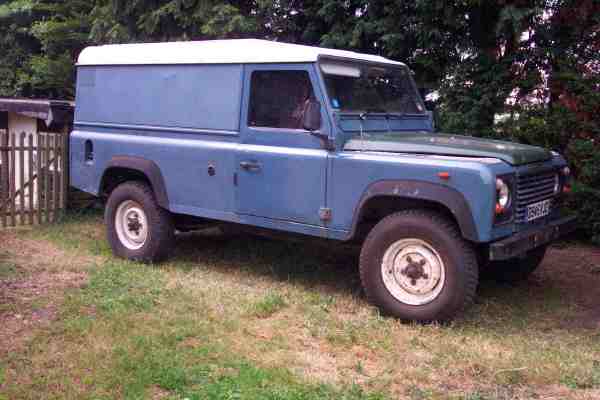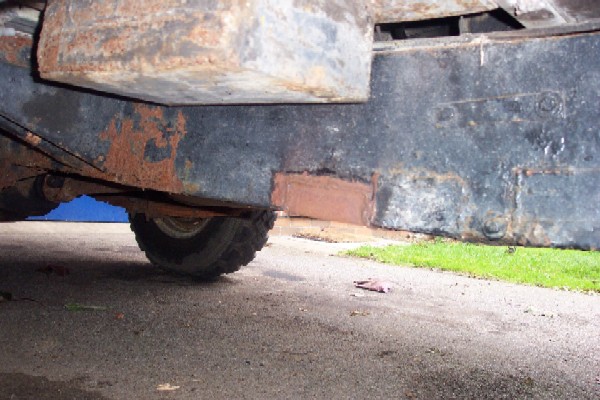![]()

Buying a Land Rover
A guide for
the novice
![]()
![]()
Are you looking to buy your first Land Rover? Confused by all the different models? Bewildered by conflicting advice from friends, colleagues and 'experts'? Then read on - I* am here to help you choose the vehicle that is right for you.
* Richard Hall, proprietor of Glencoyne Engineering

It's a Land Rover all right. But is it the right one for you? Read on to find out.
The first thing to understand is that there are an almost infinite number of variations on the basic Land Rover design. Since 1958 there have been three basic chassis lengths, about half a dozen different engines and dozens of permutations of seating, loadspace and window arrangement to choose from. Thanks to the bolt-together modular construction of Land Rovers, it can often be easier to modify an existing vehicle to suit your requirements than to try and find one which already meets them. That is why, before I even think about showing you any vehicles for sale, I like to understand what you will be asking your Land Rover to do. Towing a horsebox? Camping holidays? Offroad adventures? Carrying two people, or twelve? Long distances, or just local trips? The more information you can give me, the better.
There are many myths surrounding Land Rovers, so let's demolish a few of them at this stage.
Myth: Land Rovers are made from aluminium, so they don't rust.
Truth: Most of the outer body panels on a Land Rover are indeed aluminium. But the vehicle is built on an old-fashioned ladder frame chassis. This is what gives a Land Rover its strength: it is made from mild steel sections welded together, it is given a bare minimum of corrosion protection at the factory, and it rusts very readily indeed. Any vehicle more than ten years old may be suffering from chassis corrosion: the condition of the visible body panels provides no guide to the state of the chassis, and chassis replacement is a very expensive job. (However, it is worth mentioning that most Japanese 4x4s are far more rot-prone than Land Rovers.)

This patchwork quilt is even worse than it looks. The bottom face of the chassis was so rotten I could poke my fingers through it. The vehicle actually looked quite smart from above...
The other crucial structural component is the bulkhead - the structure to which the windscreen, dashboard, steering column, doors, bonnet and front wings are bolted. This, like the chassis, is a safety-critical item, and guess what? It's made from mild steel, and it rusts. Replacing a bulkhead is almost as involved and expensive as chassis replacement.
Other areas where steel is used include the door frames, the storage boxes under the front seats, and the protective cappings along the top and rear corners of the bodywork. Any of these areas can rust extensively, and often do. Further problems can arise where steel and aluminium meet - a chemical reaction results in the aluminium being eaten away and turning into a crumbly white powder. This is most common around the edges of the doors.
The best thing you can do to protect your new purchase is to buy a pressure washer (a cheap one will do) and make sure you regularly power wash the chassis, especially the hollow sections where mud and road salt can accumulate. A clean chassis will rust only slowly: a mud and salt-encrusted one will disappear much faster.
Myth: Land Rovers are so tough, they go on forever.
Truth: Land Rovers are indeed tough and strongly built, but they are not indestructible, and they do not respond well to neglect. A Land Rover is more complex mechanically than the average family car, and it needs more frequent and extensive servicing. Neglected Land Rovers can hide some quite serious mechanical faults, appearing to drive perfectly well right up to the moment where they go bang. In addition, there are a number of well-documented weaknesses, which vary from model to model, and which can be very expensive to put right.
Myth: Only diesel Land Rovers are worth having
Truth: It depends entirely on what you are planning to do with the vehicle. For extensive off-road use with lots of short journeys, I would most probably recommend a diesel, but for some other applications the diesel's noise, harshness, lack of power and short service intervals may count against it. I am particularly enthusiastic about the 2.5 petrol engine when converted to run on LPG. This engine produces about the same power as a 2.5 turbodiesel, it is smoother, quieter, easier to start in cold weather and, running on LPG, the fuel bills are about 15-20% lower than a diesel 110. For heavy-duty towing applications the 3.5 litre petrol V8 cannot be beaten. Feel free to drop me an email and I will try to advise you on the engine and fuel option that best matches your needs.
Myth: Land Rovers cost a fortune to run.
Truth: It is true that fuel consumption, even on the diesel vehicles, is no better than that of a large family car. However, fuel costs are only part of the story. Land Rovers depreciate (lose value) very slowly compared with most cars, so you can expect to get more of your money back when you come to sell your Land Rover or trade it in for another one. There is a fiercely competitive market for spares and accessories, and you will find that many parts are actually cheaper than for even a small car. The vehicles are simple to work on, and DIY routine maintenance is well within the abilities of anyone who has ever assembled an Ikea wardrobe without having too many bits left over. And Land Rovers fall into a low insurance group. If you can afford to run an ordinary family car, you can afford a Land Rover.
Myth: The newer the vehicle, the better
Truth: Land Rover build quality has tended to be a bit variable, and the way the vehicles are treated early in life will have a huge effect on their long-term durability. It is hard to discern a pattern: I have seen mid 1990s vehicles with advanced chassis and bulkhead rot, and early 1980s vehicles still as solid as the day they left the factory. There were various key improvements in specification over the years, most notably in 1983/4 where the coil sprung 90 and 110 vehicles replaced the old leaf sprung 'Series' Land Rovers, and then in 1990 when the TDi diesel engine was introduced. However, as a general rule, you should choose your Land Rover on condition and specification, with age being one of the least important factors. In choosing a newer vehicle, you will undoubtedly be paying more, but that does not mean you will get a better or more durable vehicle for the money.
So that's given you some idea of the questions to ask. But the big question is - is an older Land Rover really for you? Click here for my article 'Living with an older Land Rover' to find out.
Hopefully this article will have given you a few ideas about the sort of questions you should be asking before you buy your first Land Rover. Feel free to call or email me for more information: as a small, independent and enthusiastic Land Rover specialist, I want to do everything I can to find you the Land Rover that is right for you.
To see my current stock of vehicles click here.